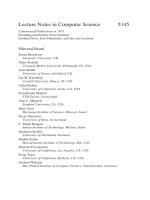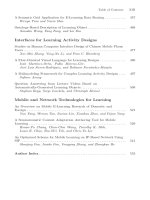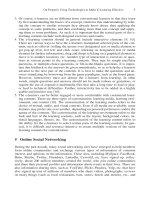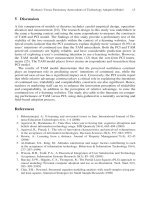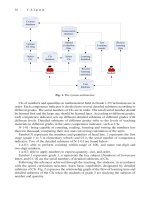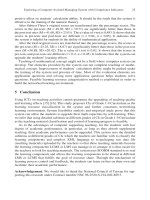Lecture Notes in Computer Science- P20 ppsx
Bạn đang xem bản rút gọn của tài liệu. Xem và tải ngay bản đầy đủ của tài liệu tại đây (254.8 KB, 5 trang )
Course Material Research Based on Perti Net 85
“ ” means Void MS, “|” means Void KP, t
stop
means the Stop KP set, and X
stop
means the Stop MS. (a) a MS is the Ancestor MS of other two MS, for example X12;
(b) a MS reflects KP set with two or more KP, for exaple X6; (c) a material can be
taught until two or more KP are mastered. Different from (b), it describes a material
reflecting a new KP, which has two or more In-arc in KP net, for exampe X4; (d) the
end of the courseware means that all KP without Out-arc in the KP net migrate to the
Stop MS, For example KP D and E.
4.3 Experiment
Based on the material accessibility of MPN, the dynamic behavour of MS can be
analyzed. In the graph of a MPN, (n) means that this MS have n number material.
Example 2: About example 1, assumed
X12 has three material, X5 has three material, etc. See figure 4.
C
t
stop
X
start
X12
(3)
X5
(
3
)
X3
(
3
)
X7
(
1
)
X6
(
3
)
X
4
X
stop
BC
E
B
D
A
Fig. 4. MPN of the Example 2
Based on the figure 4, some conclusions can be given:
• A transition sequence X
start
, X12, A, X5, B, X3, C, BC, X7, E, X4, D, t
stop
, X
stop
can be found. Therefore, it has a path from X
start
to X
stop
without the MS X6. Of
course, if X6 is learned, the impressions of KP B and KP C can be enforced.
• If the KP B does not longer present in the syllabus for teaching innovation, the
transition E, BC and D would not be accessed and the MS X4, X6 and X7 can
not be learned in the courseware.
• It is assumed that a KP sequence A, C, D, t
stop
exists. But, we can not find any path
conforming with it. Thus, the assumption is inconsistent with teaching requirement.
• The t
stop
is the Stop KP. If one KP does not be learned, it would not exist a tran-
sition from t
stop
to X
stop
. Thus, if some KP are not reflected in the selected MS,
this courseware will not be able to cover with the syllabus.
86 K. Xiao, S. Chen, and X. Chen
• If a new KP F is increased, there would not have a transition sequence from Xstart
to Xstop. Thus, the MS reflecting KP F must be increased in the courseware.
5 Conclusion
Nowdays, many researcher concern the auto-generation courseware in e-learning, and
ignore what MS is fit of the courseware. The MPN can be used to analyse some prop-
erty of MS. It can validate the case whether the KP reflected in MS exceeds the scope
of the syllabus. It can also solve the problems what MS should be deleted when the
KP does not longer present in the syllabus. And, it can judge whether the selected MS
are enough to illustrate the syllabus. When new KP is added to a syllabus, it can also
tell us about whether all MS in the courseware are enough to illustrate the syllabus
still. The future work is how to construct knowledge component based on this re-
search and to develope the courseware generation system.
References
1. Lytras, M.D., Pouloudi, A., et al.: Knowledge Management Convergence - Expanding
Learning Rontiers. Journal of Knowledge Management 6(1), 40–51 (2002)
2. Marshall, S., Mitchell, G.: Applying SPICE to E-learning: An E-Learning Maturity
Model? In: Proceedings of the sixth conference on Australasian computing education,
Dunedin, New Zealand, pp. 185–191. Australian Computer Society, Inc, Darlinghurst,
Australia (2004)
3. Karampiperis, P., Sampson, D.: Designing Learning Systems to Provide Accessible Ser-
vices. In: Proceedings of the 2005 International Cross-Disciplinary Workshop on Web Ac-
cessibility, Chiba, Japan, pp. 72–80 (2005)
4. Shenquan, X.: Analysis of the Properties of Knowledge Points and Their Networks. Jour-
nal of Software 9(10), 785–789 (1998)
5. Brusilovsky, P.: KnowledgeTree: A Distributed Architecture for Adaptive E-learning. In:
Proceedings of the 13th international World Wide Web conference, New York, USA
(2004)
6. Yeh, I., Karp, P.D., et al.: Knowledge Acquisition, Consistency Checking and Concur-
rency Control for Gene Ontology. Bioinformatics 19(2), 241–248 (2003)
7. Psyché, V., Bourdeau, J., et al.: Making Learning Design Standards Work with an Ontol-
ogy of Educational Theories (October 2006),
/>IED05.pdf
8. Cesarini, M., Monga, M., et al.: Carrying on the E-learning Process with a Workflow
Management Engine. In: Proceedings of the 2004 ACM symposium on Applied comput-
ing, Nicosia, Cyprus, pp. 940–945. ACM Press, New York (2004)
9. Murata, T.: Petri Nets: Properties, Analysis and Applications. Proc. IEEE 77(4), 541–580
(1989)
10. Juan, H., Li-Hui, L., et al.: Analysis for Reachability Problem of Petri Net. Journal of Soft-
ware 15(7), 949–955 (2004)
11. Stotts, P.D., Furuta, R.: Petri-net-based Hypertext: Document Structure with Browsing
Semantics. ACM Transactions on Information Systems 7(1), 3–29 (1989)
F. Li et al. (Eds.): ICWL 2008, LNCS 5145, pp. 87–98, 2008.
© Springer-Verlag Berlin Heidelberg 2008
The Practice and Experience Sharing of Three-Year
Peer Coaching Program in Taiwan
Ya-Ting Carolyn Yang
1
, Wan-Chi Wu
1
, Pei-Yun Chung
2
, Chi-Sung Laih
2
,
Jia-Rong Wen
3
, Chi-San Lin
4
, and Jian-Bin Gao
1
1
Institute of Education, National Cheng Kung University
{yangyt,u3696107,u3696112}@mail.ncku.edu.tw
2
Department of Electrical Engineering, National Cheng Kung University
3
Dean of University Development Committee, Shu-Te University
4
Department of Information and Learning Technology, National University of Tainan
Abstract. The Peer Coaching Program has been in place in Taiwan for more than
two years. We have not only trained 165 local facilitators, but also held 92
training courses for the coaches. In addition, we have established the website,
PBL.NET, which provides personal experience sharing, online materials search,
and online courses. Currently, more than 7,000 elementary, junior, and senior
high school teachers and students participate in the program. PBL.NET includes
more than 2,100 WebQuest lessons and provides more than 1,180 online courses.
The evaluation results indicate that the Peer Coaching Program is very successful
in Taiwan. Our ultimate goals are to implement a professional development
model so as to provide an excellent digital learning environment, to advance
teachers’ skills, to enhance standards-based instruction through engaged learning
and technology, and finally, to increase students’ learning achievements.
1 Introduction
With the exponential growth and development of Information and Communication
Technologies (ICT), teachers must be able to prepare students to adapt to the changes in
this technology-driven society. Because technology is prevalent in nearly all our ac-
tivities, the public expects it to be used to enhance student achievement and prepare
future business owners and employees (Schwab, 2000). Both national and state poli-
cymakers have acknowledged its importance and are working to ensure its incorpora-
tion into K-12 education (Austin, 2004). Recently, the Taiwanese government has
endeavored to promote various projects to construct a digitalized and informationalized
learning environment. Although how to build a complete coaching model to improve
teachers’ ability of using digital technology is one of the biggest challenges in Taiwan,
many studies (Miller, 1998; Saye, 1998; Tonkin & Baker, 2006) suggested that peer
coaching can be a successful model. It is because peer coaching offers the teachers
opportunities to become involved in meaningful discussions and planning, observe
other teachers, be observed, and receive feedback (Loucks-Horsley, Hewson, Love, &
Stiles, 1998) to help teachers use technology in ways that promote engaged learning.
Therefore, now that we have had the chance to introduce the Peer Coaching Program
88 Y T. Carolyn Yang et al.
into Taiwan, we believe that this program is one of the best solutions to such
challenges.
2 Team Members of the Peer Coaching Program
The principle investigator of the Peer Coaching Program in Taiwan is Professor
Chi-Sung Laih from the Department of Electrical Engineering, National Cheng Kung
University. He has taken the responsibility to plan and implement the whole program.
There are also three other professors in Educational Technology who are involved in
the program—Jia-Rung Wen (Dean of the University Development Committee,
Shu-Te University), who is in charge of designing the WebQuest training session,
Chi-Syan Lin (Professor in the Department of Information and Learning Technology,
National University of Tainan), who is taking responsibility for the design of the
“Knowledge Management & Learning Community System” training session, and the
development of the PBL.NET website, and Ya-Ting C. Yang (Associate Professor in
the Institute of Education, National Cheng Kung University), who is responsible for the
design of the “Coaching Skills” and the implementation of the program evaluation. In
addition, our team includes one full-time project assistant and six graduate teaching
assistants who work collaboratively to provide logistics support for the training ses-
sions, perform on-site practical work such as data collection for the evaluation of this
program, and interact regularly with the schoolteachers and professors in a timely,
helpful, and professional manner.
3 Implementation Procedure of the Peer Coaching Program
Professor Lai was in charge of the implementation procedures of this program. The
tasks in this part included planning the content and details of the whole training pro-
gram, supervising how each member preceded with his/her tasks, and most important
of all, communicating with the Ministry of Education and the Education Bureaus and
helping them understand the goal of the Peer Coaching Program in order to receive full
support from the government. In the two conventions held so far, we received some
very helpful supports, which are listed as follows:
z The Ministry of Education has given us full support without any intervention.
z Delegates from 23 counties and cities in Taiwan are involved in this program.
All of them show high willingness to participate in the training activities.
z The purposes of the Peer Coaching Program have been highly accepted by most
of the participants. Our team provides resources and contact points that help and
lead all the Peer Coaching training initiatives in Taiwan.
The relationships among the elements are shown in Figure 1. The promotion and im-
plementation of this project require the participation and cooperation of government and
elementary, junior, and senior high school teachers from all the counties and cities in
The Practice and Experience Sharing of Three-Year Peer Coaching Program in Taiwan 89
Fig. 1. The relationship of constructing a digitalized learning environment
Fig. 2. The implementation of the Peer Coaching Program for elementary and junior high school
teachers
Taiwan. Figure 2 shows the relationships among them and the way this project is being
implemented in Taiwan.
The training mode of local facilitators (LFs, teachers who have experience in
teaching information technology relevant classes) and coaches (teachers who have
taken information technology relevant courses) is flexible based on the responses from
participants. The first year we recruited 45 groups of LFs (a total of 90 LFs) to par-
ticipate in a three-day training program. Most of the coach training sessions were held
by LFs in the first year (with a total of 24 coach training sessions). Due to the unex-
pected success, we held the LF training sessions in three different places (north, mid,
and south Taiwan) during the second year. In addition, each LF only needed to be
responsible for training 25 coaches (each LF was responsible for training 36 coaches
during the first year). We also held two principal training sessions in the north and
south of Taiwan, and several coach training sessions through the education bureaus of
cities and counties that we contacted directly. In the third year, Microsoft School of the
Future project was initiated in Kaohsiung; thus, we held one LF training session at
Kaohsiung for the project. We also offered online courses for coach training to attract
